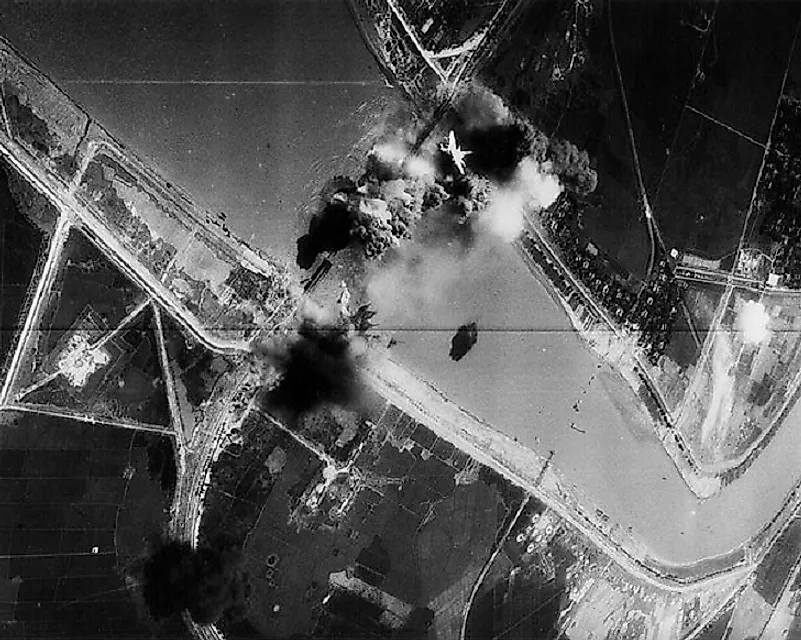Operations Linebacker 1 & 2 - Vietnam War

5. Background
The purpose of the Operation was to slow down the transportation of any kind of supplies for the Nguyer Hue Offensive (known as the Easter Offensive), an invasion of the Republic of South Vietnam, that had been launched on the 30th of March 1972. Linebacker was the first large-scale, continuous bombing effort of the Americans against Vietnam since November of 1968, when Operation Rolling Thunder ended.
4. Makeup
In Operation Linebacker I, the U.S. Air Force (USAF) and South Vietnamese Air Force (VANF) were led by General John Vogt, Jr., who became commander-in-chief of the USAF-in-Europe following the Vietnam War. The North Vietnamese air force, known for their use of Russian-built MiGs and other Russian- and Chinese-manufactured equipment, was led by Nguyen Van Tien. In Operation Linebacker II, B-52s and around 2,000 supporting aircraft faced more than a hundred North Vietnamese aircraft, high-altitude surface-to- air missiles designed in the Soviet Union, and numerous North Vietnamese anti-aircraft batteries on the ground. The U.S. aerial forces were led by the coordinated collaboration of General Vogt, USAF Chief of Staff John Ryan, and Strategic Air Commander John Meyer.
3. Description
Ten days after the operation started on April 6th , B-52s were escorted by fighter and aircraft, specializing in electronic countermeasures and suppression of surface-to- air missiles, in order to bomb the fuel storage tanks at Haiphong and Hanoi, setting fires all over the areas. In fact, these fires were visible from 110 miles away. When these aerial attacks failed, the naval aircraft began mining the harbors on 8th of May and, two days later, the administration extended the aerial campaign. At this time, around 30,000 of Vietnamese troops, which were supported also by regiments of tanks and artillery, moved south across the Demilitarized Zone, that separated the two Vietnamese nations. After 6 months of bombing North Vietnam, President Nixon continued with the peace talks in Paris but, when bombed again by North Vietnam in December, he realized that these negotiations likely wouldn't work out.
More specifically, after a 72-hour ultimatum, which had no response, he ordered Operation Linebacker 2, which took place between the 18th and 29th of December, 1972, when the Americans bombed Hanoi and other targets in North Vietnam. In fact, around 700 B-52 sorties attacked the military and industrial center at Haiphong, Hanoi. This campaign focused mainly on high altitude radar bombing, especially at night by B-52s with massive waves of attacks with 4-5 intervals. Actually, Linebacker 2 was an altered extension of the Linebacker bombings that took place earlier, from April to October. In terms of the tactics employed employed in these two campaigns, the American aircraft attacked strategic targets like power plants, airfields, and radio stations, which disrupted the supplies and reinforcement to the units that were fighting in South Vietnam. These bombs (laser-guided) were very effective, severing the bridge at Thanh Hoa. The North Vietnamese made use of different tactics, in order to cross the streams and they usually moving on at nights with ferries or even with movable bridges. Their use of SAMs were not very effective against American fighters, but they were quite effective in forcing the American fighters to altitudes of 3,000 feet. The Vietnamese in fact failed to have the control of the war in the sky and this was partially because the American radar was able to detect enemy interceptors rising from runways.
2. Outcome
Interestingly enough, both sides claimed victory in the first Operation Linebacker, and Operation Linebacker II is considered to have had an outcome where neither side gained any relative advantage. Over the course of Linebacker I, the U.S. and South Vietnamese combined to lose 144 aircraft, while the North Vietnamese lost 63 of their own. During Linebacker II, 16 B-52s and 12 other American aircraft were shot down, with many more damaged, 43 Americans were killed, and 49 more were taken prisoner. For the Communists, there was a loss of 6 MiG-21s. Unfortunately, more than 1,600 innocent civilians were killed in Linebacker II.
1. Significance
During the Operation Linebacker 2 around 741 B-52 sorties had bombed North Vietnam and 729 of them struck their aimed targets. In addition, 212 more sorties had bombed South Vietnam in order to support the operations on the ground. The damage incurred by the infrastructure of the North Vietnamese military was catastrophic. It was estimated that around 500 rail interdictions took place, 3 million gallons of products of petroleum destroyed, and around 80% of the electrical power capabilities of North Vietnam were eliminated during the operation. Despite claiming it was a success to the American public, the operation achieved little either strategically or tactically for the U.S., and tarnished Nixon’s reputation as an effective wartime leader. China, the Soviet Union, and even several leaders from United Nations denounced the attacks. The operations were said to be the largest scale U.S. Air Force bombing endeavors since World War II.











